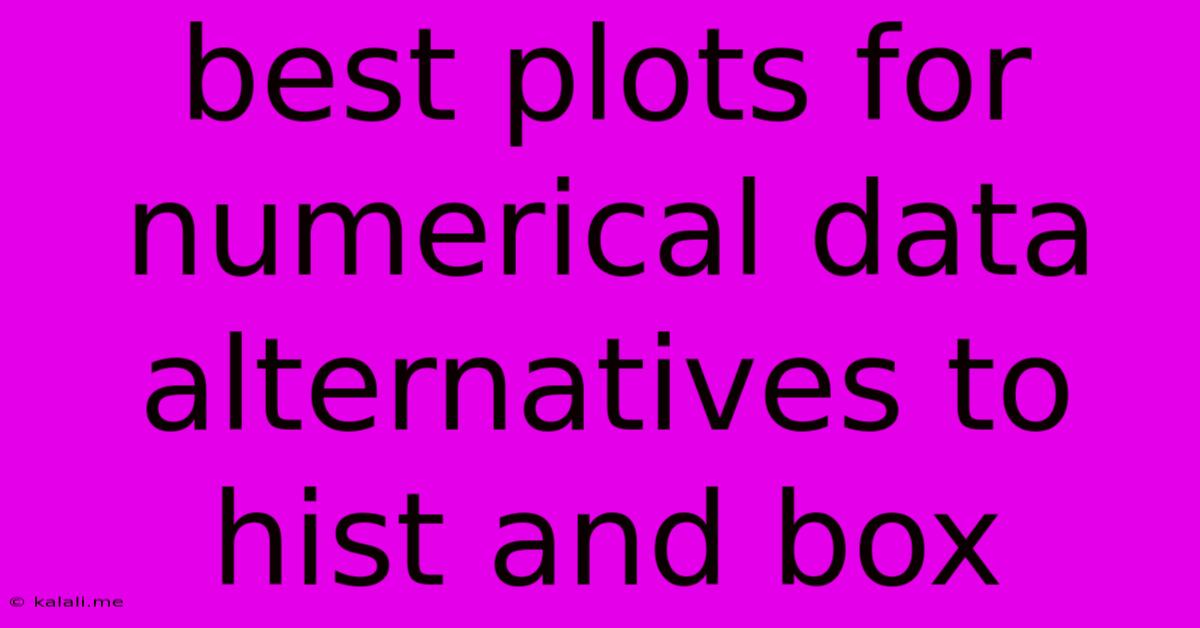Best Plots For Numerical Data Alternatives To Hist And Box
Kalali
Jun 08, 2025 · 3 min read

Table of Contents
Beyond Histograms and Box Plots: Unveiling the Best Alternatives for Visualizing Numerical Data
Histograms and box plots are staples of data visualization, offering quick insights into the distribution and central tendency of numerical data. However, their limitations become apparent when dealing with large datasets, complex distributions, or a need for more nuanced comparisons. This article explores compelling alternatives that provide richer visualizations and deeper understanding of your numerical data. We'll examine their strengths, weaknesses, and best use cases, helping you choose the optimal plot for your specific analytical needs.
Why Explore Alternatives to Histograms and Box Plots?
While histograms and box plots serve their purpose well, they can fall short in certain situations. Histograms can be cluttered with high-density data, obscuring important details. Box plots, while excellent for summarizing key statistics, lack the granularity to reveal the full shape of the distribution. Alternatives offer a more comprehensive and insightful visualization of your numerical data.
Powerful Alternatives for Visualizing Your Numerical Data
Here are some excellent alternatives to histograms and box plots, each with its own unique advantages:
1. Violin Plots: Combining the benefits of box plots and kernel density estimations, violin plots provide a richer representation of the data distribution. They display both the probability density of the data at different values (like a mirrored kernel density plot) and the data's quartiles (similar to a box plot). This gives a clear picture of the distribution's shape, symmetry, and presence of outliers. They're especially useful for comparing distributions across different groups.
2. Density Plots (Kernel Density Estimation): Density plots offer a smooth, continuous representation of the probability density of a numerical variable. They're great for visualizing the overall shape of the distribution, identifying modes (peaks), and revealing subtle patterns that might be missed in a histogram. Ideal for showcasing the overall distribution and identifying potential multimodal distributions.
3. Bean Plots: A less common but increasingly popular alternative, bean plots combine elements of box plots and density plots. They present the data distribution using a combination of a box plot and a density trace, allowing for a comparison of both summary statistics and the overall distribution shape. Especially useful for comparing multiple groups simultaneously.
4. Strip Plots (or Dot Plots): For datasets that aren't excessively large, strip plots offer a simple yet effective way to visualize the distribution of data points. Each data point is represented as a single dot on the plot, making it easy to identify clusters, outliers, and the overall spread of the data. Excellent for smaller datasets and highlighting individual data points.
5. Ridgeline Plots: These visually appealing plots are perfect for comparing multiple distributions simultaneously. Each distribution is represented as a separate density plot, arranged vertically, creating a series of overlapping "ridges." This allows for easy visual comparison of the shapes and locations of multiple distributions. Ideal for comparing distributions across categories or time periods.
Choosing the Right Plot: Considerations and Best Practices
The choice of the best plot depends heavily on the nature of your data and the insights you're seeking. Consider the following factors:
- Dataset size: For extremely large datasets, density plots or violin plots are generally preferred over strip plots.
- Number of groups: For comparing multiple groups, violin plots, bean plots, or ridgeline plots are highly effective.
- Desired level of detail: If you need a highly detailed view of the data distribution, density plots are a strong choice. If a summary is sufficient, box plots or bean plots might be more appropriate.
- Presence of outliers: Violin plots effectively highlight outliers, while box plots explicitly mark them.
By carefully considering these factors, you can select the visualization that best communicates the story held within your numerical data. Remember, effective data visualization isn't just about choosing the right plot—it's about presenting your findings clearly and concisely, leading to deeper insights and better decision-making.
Latest Posts
Latest Posts
-
How To Heat A Frozen Burrito
Jun 09, 2025
-
How To Kill The Wither Easily In The End
Jun 09, 2025
-
How To Attach Casters To Metal Legs
Jun 09, 2025
-
What Does Econ Mean On Ac
Jun 09, 2025
-
How Old Are Romeo And Juliet In The Play
Jun 09, 2025
Related Post
Thank you for visiting our website which covers about Best Plots For Numerical Data Alternatives To Hist And Box . We hope the information provided has been useful to you. Feel free to contact us if you have any questions or need further assistance. See you next time and don't miss to bookmark.